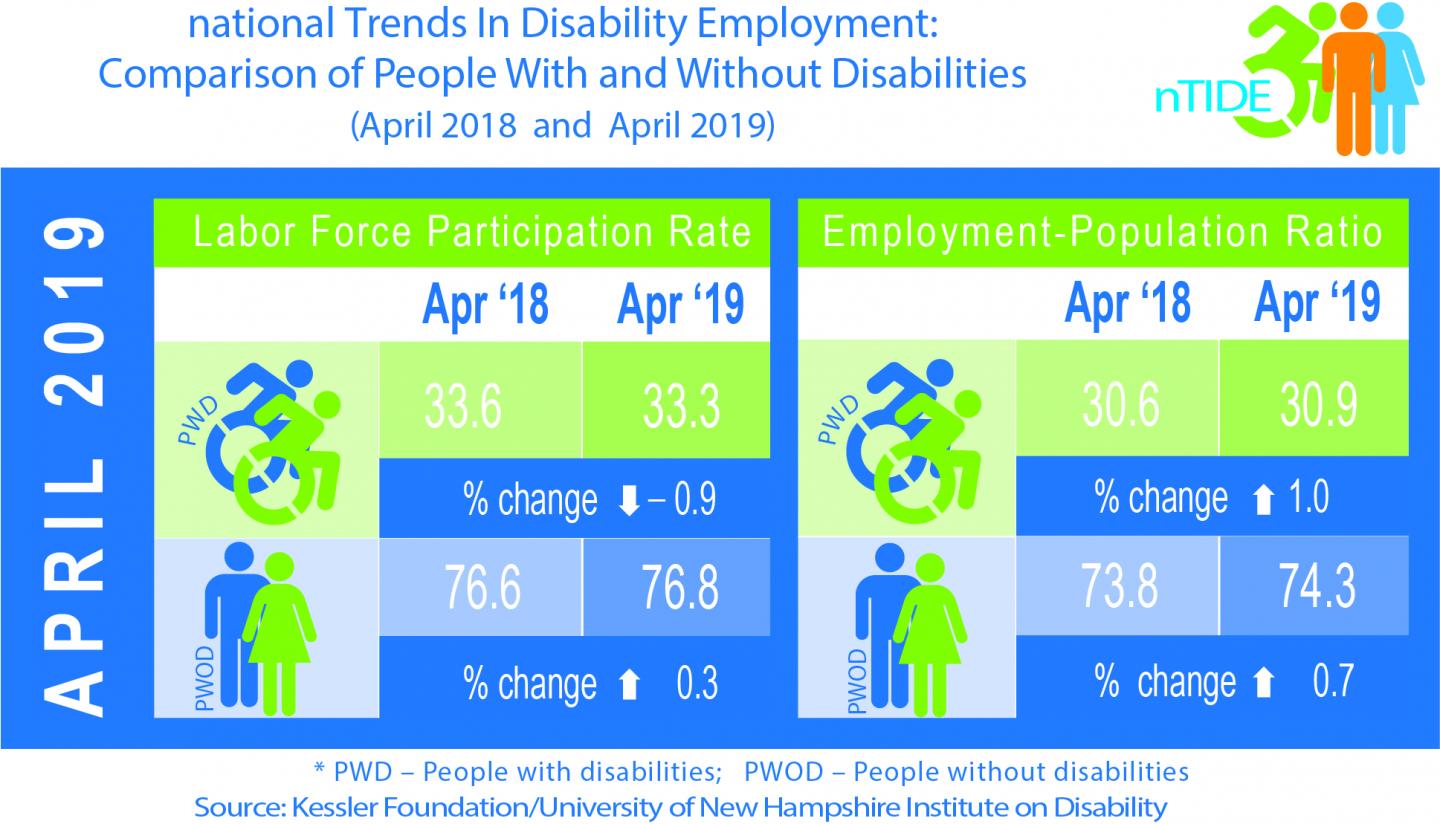nTIDE April 2019 Jobs Report: Kessler Foundation and University of New Hampshire release nTIDE Report – Monthly Update – The Disability Equality Index, a joint workplace inclusion initiative of AAPD and Disability:IN,

Credit: Kessler Foundation
East Hanover, NJ – May 3, 2019 – The economic indicators for Americans with disabilities were flat, while people with disabilities saw slight gains, according to today’s National Trends in Disability Employment – Monthly Update (nTIDE), issued by Kessler Foundation and the University of New Hampshire’s Institute on Disability (UNH-IOD). This raises questions about the challenges of full employment for jobseekers with disabilities.
Many employers have diversity policies for hiring and recruitment, but disability is specified in only a small percentage of policies. For most employers, diversity means gender, race, religion, and sexual orientation. The potential contributions of employees with disabilities to corporate culture and productivity are often overlooked. The Disability Equality Index, a joint initiative of the American Association of People with Disabilities (AAPD) and Disability:IN, offers businesses an objective way to evaluate their disability policies and practices, and identify opportunities for improving inclusion of people with disabilities in the workplace.
Learn more about today’s job numbers and strategies for improving disability inclusion in the workplace from the May 3 nTIDE webinar. Listen live, or visit the archives at https:/
In the Bureau of Labor Statistics Jobs Report released Friday, the employment-to-population ratio for working-age people with disabilities increased slightly from 30.6 percent in April 2018 to 30.9 percent in April 2019 (up 1.0 percent or 0.3 percentage points). For working-age people without disabilities, the employment-to-population ratio also increased slightly from 73.8 percent in April 2018 to 74.3 percent in April 2019 (up 0.7 percent or 0.5 percentage points). The employment-to-population ratio, a key indicator, reflects the percentage of people who are working relative to the total population (the number of people working divided by the number of people in the total population multiplied by 100).
“In spite of the labor market’s continuing strength that has created a sustained need for workers, people with disabilities are not seeing more benefits,” said John O’Neill, PhD, director of employment and disability research at Kessler Foundation. “Let’s hope that for the remainder of 2019 that we return to the 2016-2018 pattern of steady improvement in the employment situation for people with disabilities.”
The labor force participation rate for working-age people with disabilities decreased slightly from 33.6 percent in April 2018 to 33.3 percent in April 2019 (down 0.9 percent or 0.3 percentage points). For working-age people without disabilities, the labor force participation rate increased slightly from 76.6 percent in April 2018 to 76.8 percent in April 2019 (up 0.3 percent or 0.2 percentage points). The labor force participation rate is the percentage of the population that is working or actively looking for work.
“As full employment continues, it is surprising that the positive trends for people with disabilities that we saw in 2016-2018 are not also continuing,” noted Andrew Houtenville, PhD, associate professor of economics at UNH and research director of the Institute on Disability. “This pattern suggests that the jobs available when we reached full employment a couple of years ago may have been better matches for people with disabilities than jobs that are becoming available today.”
The continuing strength of the labor market has created a sustained need for workers in many sectors of the economy. Given the unmet needs, the economic climate is more favorable to populations that are traditionally bypassed by businesses, including job seekers with disabilities. The Disability Equality Index helps companies audit their human resource policies, and identify where they can maximize their opportunities to hire qualified individuals with disabilities. Those that succeed reap the benefits of higher revenue, higher net income, and improved profit margins. Increased diversity inclusion in the workplace could have a substantial impact on the general economy, according to Jill Houghton, president and CEO of Disability:IN. Houghton estimates that the nation’s GDP (gross domestic product) could increase by $25 billion if just one percent of job seekers with disabilities joined the labor force.
Companies can improve the outcomes of their efforts to recruit, hire, and retain individuals with disabilities in a number of ways, according to the 2017 Kessler Foundation National Employment and Disability Survey: Supervisor Perspectives. More than 6,000 supervisors provided information about the employer practices, how effective these are for employees with and without disabilities, and which practices are effective, but underutilized for individuals with disabilities. Companies can boost inclusion by making their practices more effective for employees with disabilities, and by adopting effective, but underutilized practices.
Partnering with local disability organizations for recruitment was effective, as was outside assistance with job training, but both were underutilized by employers. Supervisors reported that having an established process for requesting accommodations was very effective, but in place in only 34 percent of companies. Similarly, having a centralized accommodations fund was viewed as extremely effective, but available in only 16 percent of companies. Among hiring practices, supervisors reported benefits in being trained in accessible application and interview techniques, and in review of hiring procedures to ensure accessibility, but less than half of companies offered these.
“Broader implementation of effective practices could expand employment opportunities for individuals with disabilities,” noted Dr. O’Neill, a survey co-author, “but overall, the survey revealed that the key factor in disability inclusion was the commitment of upper management to the success of supervisors and employees.”
###
Visit http://www.
In April 2019, among workers ages 16-64, the 4,771,000 workers with disabilities represented 3.3 percent of the total 146,645,000 workers in the U.S.
Join our nTIDE Lunch & Learn series today, May 3, at 12:00 pm Eastern. This live broadcast, hosted via Zoom Webinar, offers attendees Q&A on the latest nTIDE findings, provides news and updates from the field, as well as invited panelists to discuss current disability-related findings and events. Jill Houghton, president and CEO of Disability:IN, joins Dr. Houtenville, Dr. O’Neill, and Denise Rozell, Policy Strategist at AUCD. Join live or watch the recordings at: http://www.
NOTE: The statistics in the nTIDE are based on Bureau of Labor Statistics numbers but are not identical. They are customized by UNH to combine the statistics for men and women of working age (16 to 64). nTIDE is funded, in part, by grants from the National Institute on Disability, Independent Living and Rehabilitation Research (NIDILRR) (9ORT5022 and 90RT5017) and Kessler Foundation.
About Kessler Foundation
Kessler Foundation, a major nonprofit organization in the field of disability, is a global leader in rehabilitation research that seeks to improve cognition, mobility, and long-term outcomes — including employment — for people with neurological disabilities caused by diseases and injuries of the brain and spinal cord. Kessler Foundation leads the nation in funding innovative programs that expand opportunities for employment for people with disabilities.
For more information, visit http://www.
About the Institute on Disability at the University of New Hampshire
The Institute on Disability (IOD) at the University of New Hampshire (UNH) was established in 1987 to provide a coherent university-based focus for the improvement of knowledge, policies, and practices related to the lives of persons with disabilities and their families. For information on the NIDILRR-funded Employment Policy and Measurement Rehabilitation Research and Training Center, visit http://www.
For more information, or to interview an expert, contact:
Carolann Murphy, 973.324.8382, [email protected].
Media Contact
Carolann Murphy
[email protected]




